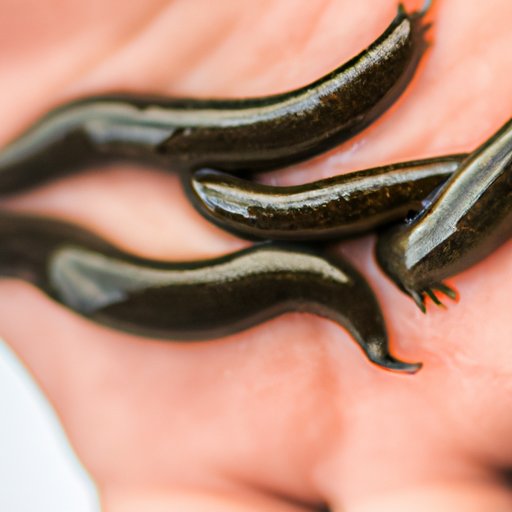
Introduction
Leeches have been used in medicine for centuries, and despite the advances in technology, they remain an important part of contemporary medicine. Leech therapy, also known as hirudotherapy, is still used in modern medicine to treat a range of ailments and diseases. It may sound like an outdated and gruesome medical practice, but the use of leeches in medicine has evolved throughout history, and continues to make progress. In this article, we will explore the history of leech therapy, the mechanics of medical leech therapy, the benefits and drawbacks of using leeches in modern medicine, the science behind the action, and patient testimonials to provide a comprehensive overview of leech therapy in modern medicine.
History of Leeches in Medicine: An Overview of How They Were Used and How They Are Being Used Today
The use of leeches in medicine has a long history dating back to ancient times. They were used by Egyptians, Indians, and Greeks, to treat a range of illnesses and diseases such as skin diseases, nervous system disorders, and gastrointestinal problems. They were also used for bloodletting, which was believed to balance the body’s humors. However, with the advent of modern medicine, the use of leeches diminished and became sporadic.
It wasn’t until the latter part of the 20th century that leech therapy began to make a comeback. In 2004, the FDA approved the use of medicinal leeches for specific medical treatments, bringing leech therapy back into the medical mainstream.
The Mechanics of Medical Leech Therapy: How Leeches are Used to Treat Ailments and Diseases
Leech therapy is not a one size fits all treatment and is typically used for specific ailments and diseases that require blood flow or decongestion. Leech therapy uses the saliva from leeches which contains over 100 bioactive proteins and peptides, including anticoagulants, which prevent blood clots, anti-inflammatory agents, and anesthetic compounds.
The process of medical leech therapy typically involves placing live medical leeches on the patient’s skin over the affected area, where the leeches will naturally attach themselves. The leech saliva secreted through the leech bites can help promote blood flow and circulation, reduce pain and inflammation, and break down blood clots that may be causing congestion. The therapy can also help increase the oxygen supply to the affected area, which can aid in recovery.
The Benefits and Drawbacks of Using Leeches in Modern Medicine
Leech therapy has many potential advantages, including its ability to promote blood flow and circulation, reduce pain and inflammation, and treat congestive disorders. Leech therapy can also be used as an alternative to surgery in certain cases or as a supplement to post-surgical healing. Therapy using leeches typically has a low risk of adverse reactions. Some drawbacks to using leech therapy include the cost of leeches and the lack of uniformity in treatment outcomes. Additionally, some patients may experience side effects such as itching, redness, or infection at the site of the leech bites.
The Science Behind the Action: Understanding the Physiology of Leeches and Why They Are Still an Important Part of Some Medical Practices
Leeches are not just beneficial due to their ability to promote blood flow and circulation, but also because of their many useful enzymes in their saliva. The enzymes present in the saliva of medicinal leeches can help prevent the formation of clots, improve blood flow, and combat inflammation. This therapy can also be used to treat a range of conditions unrelated to blood flow and circulation due to the anti-inflammatory, healing, and pain-reducing enzymes present in the leech saliva.
Leech Therapy in Action: Patient Testimonials of How Leeches Have Helped in Their Treatment and Recovery
There are numerous testimonials from patients who have successfully undergone leech therapy for various ailments and injuries. Some patients reported successful treatments for joint pains, skin grafts, and blood disorders. They have been used successfully in some clinical trials to reduce pain, treat osteoarthritis, and improve healing. Although individual experiences may differ, leech therapy overall seems to have a positive influence on medical treatment outcomes.
Conclusion
After reviewing the history of leech therapy, the mechanics of medical leech therapy, and the benefits and drawbacks of using leeches in modern medicine along with patient testimonials, it is clear that leech therapy is still an important part of contemporary medicine. With its proven benefits in promoting blood flow, reducing inflammation, and improving healing outcomes, leech therapy can be a valuable asset to many medical practices. Those interested should take some time to consider all the potential benefits and drawbacks, and discuss any questions or concerns with their healthcare provider.
As research on leech therapy continues to progress, further studies are needed to understand the full potential and limitations of the therapy. We call for further research to help establish the precise role of leech therapy in modern medicine.




